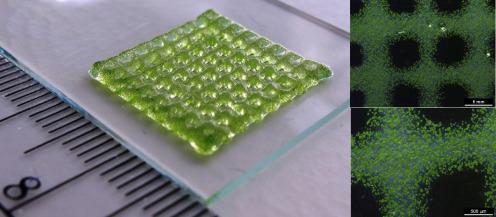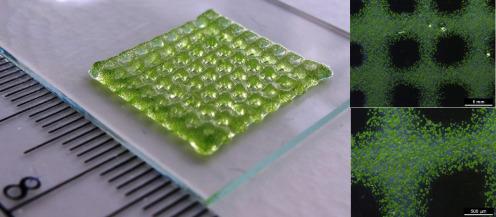
Credit: Photo: Anja Lode, TU Dresden
An international team of researchers led by Professor Michael Kühl at the Department of Biology, University of Copenhagen has just published a breakthrough in 3D bioprinting. Together with German colleagues at the Technical University of Dresden (Centre for Translational Bone, Joint and Soft Tissue Research), Professor Kühls group implemented oxygen sensitive nanoparticles into a gel material that can be used for 3D printing of complex, biofilm and tissue like structures harboring living cells as well as built-in chemical sensors. The work has just been published in the leading materials science journal, Advanced Functional Materials.
Kühl explains: "3D printing is a wide spread techniques for producing object in plastic, metal, and other abiotic materials. Likewise, living cells can be 3D printed in biocompatible gel materials (bioinks) and such 3D bioprinting is a rapidly developing field, e.g. in biomedical studies, where stem cells are cultivated in 3D printed constructs mimicking the complex structure of tissue and bones. Such attempts lack on line monitoring of the metabolic activity of cells growing in bioprinted constructs; currently, such measurements largely rely on destructive sampling. We have developed a patent pending solution to this problem."
The group developed a functionalized bioink by implementing luminescent oxygen sensitive nanoparticles into the print matrix. When blue light excites the nanoparticles, they emit red luminescent light in proportion to the local oxygen concentration – the more oxygen the less red luminescence. The distribution of red luminescence and thus oxygen across bioprinted living structures can be imaged with a camera system. This allows for on-line, non-invasive monitoring of oxygen distribution and dynamics that can be mapped to the growth and distribution of cells in the 3D bioprinted constructs without the need for destructive sampling.
Kühl continues: "It is important that the addition of nanoparticles doesn't change the mechanical properties of the bioink, e.g. to avoid cell stress and death during the printing process. Furthermore, the nanoparticles should not inhibit or interfere with the cells. We have solved these challenges, as our method shows good biocompatibility and can be used with microalgae as well as sensitive human cell lines."
The recently published study demonstrates how bioinks functionalized with sensor nanoparticles can be calibrated and used e.g. for monitoring algal photosynthesis and respiration as well as stem cell respiration in bioprinted structures with one or several cell types.
"This is a breakthrough in 3D bioprinting. It is now possible to monitor the oxygen metabolism and microenvironment of cells on line, and non-invasively in intact 3D printed living structures" says Prof. Kühl. "A key challenge in growing stem cells in larger tissue- or bone-like structures is to ensure a sufficient oxygen supply for the cells. With our development, it is now possible to visualize the oxygen conditions in 3D bioprinted structures, which e.g. enables rapid testing and optimization of stem cell growth in differently designed constructs."
The team is very interested in exploring new collaborations and applications of their developments.
Kühl ends: "3D bioprinting with functionalized bioinks is a new powerful technology that can be applied in many other research fields than biomedicine. It is e.g. extremely inspiring to combine such advanced materials science and sensor technology with my research in microbiology and biophotonics, where we currently employ 3D bioprinting to study microbial interactions and photobiology."
###
The work is supported by grants from the Carlsberg Foundation, the Villum Foundation, and the Independent Research Fund Denmark via a Sapere-Aude Advanced Grant, and project grants from the Independent Research Fund Denmark, Natural Sciences (FNU) and the Independent Research Fund Denmark, Technology and Production Sciences (FTP).
Media Contact
Michael Kühl
[email protected]
45-40-47-63-04
http://www.science.ku.dk/english/
Original Source
https://www1.bio.ku.dk/nyheder/pressemeddelelser/3d-bioprinting-of-living-structures-with-built-in-chemical-sensors/ http://dx.doi.org/10.1002/adfm.201804411





